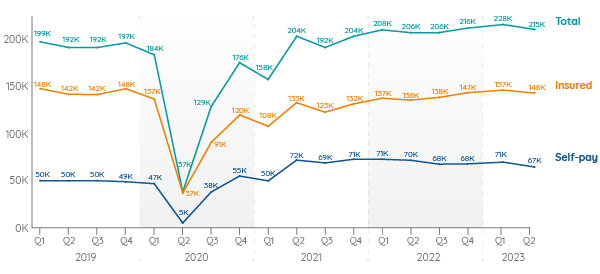The private healthcare sector is on course for a record high in the number of patients being admitted with private medical insurance (PMI) use taking off.
Insured patient admissions were up by almost 9% in the second quarter of 2023 compared to Q2 2022 while self-pay patients dipped, according to latest data from the Private Healthcare Information Network (PHIN).
In total 148,000 insured patients received private in-patient treatment from April to June.
While this was down from 157,000 in Q1 it was up from 136,000 in the same period of 2022 and was also a higher figure than any quarter last year.
Notably, insured patient numbers have remained above 147,000 for the last three quarters – on par with the pre-pandemic level.
The number of admissions using PMI rose in every English region and in Scotland (18%) in Q2 2023.
The biggest rise of insured admissions in England came in the West Midlands (13%) and the smallest in the North East (3%) while the largest rise by volume was in London (5,060).
Insured admissions only fell in Wales (10%) and very slightly in Northern Ireland (1%).
Self-pay slowing
The self-pay market, which boomed post-covid, remains well above its pre-pandemic level but has seen three of the last four quarters with below 70,000 patients admitted.
Self-pay admissions were down by 3,000 or 4% compared to Q2 in 2022, falling in every English region and in Scotland by 2%.
The biggest percentage fall in England came in the West Midlands (-15%) and the largest fall by volume was in London (-1,190).
Self-pay continued to grow in Northern Ireland (92%) and Wales (17%).
Record year ahead
Overall 215,000 people received private in-patient treatment from April to June, which followed the Q2 trend of dipping from 228,000 in the first quarter, but was still higher than three of the four quarters in 2022. (See chart)
PHIN also noted that all private admissions were up across all four nations of the UK – Northern Ireland grew the most at 28% although this was from the smallest base.
Scotland (9%), England (4% and Wales (4%) all saw more modest growth.

As a result, PHIN chief executive Dr Ian Gargan (pictured) said the sector was on course for a record year.
“Our latest figures confirm the ongoing importance of the private sector, with an increased number of admissions in every part of the UK compared to the same period last year,” he said.
“The sector is on track to record its highest ever number of admissions this year.
“Patients increasingly used private medical insurance to pay for their treatment and this upturn may be due the ongoing and extensive NHS waiting lists forcing more people to consider their healthcare options, and plan ahead, in ways that they have never had to before.
“They may feel they can no longer rely on the public health service as they have always previously done to get the operations they need in a timely manner.”
Women and diagnostics leading the way
Overall, there continued to be more female admissions than male with both having an increased number of insured admissions and reduction in self-paid admissions.
The drop in self-pay was more pronounced for female admissions at 3,400 or down 9% compared to 1,040 or 4% for males.
There was also a smaller growth in insured admissions for females at 2,235 (3%) than males at 3,280 (5%).
Dr Gargan added: “The number of people paying for diagnostics procedures, such as a colonoscopy, is also increasing as they want to be sure whether they need treatment and not risk waiting and finding out their health is deteriorating.
“We saw a surge in self-pay admissions after the Covid pandemic lockdowns as people seemingly looked to make up for lost time, but that is continuing to level off, with the number of female admissions using this payment method in particular falling.
“There was a fall in admissions for the 15-19 and 20-24 age groups. This could reflect a lower need for a significant procedure in those younger age groups, or the lack of insurance or ability to self-pay.”






